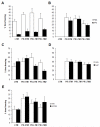Divergent cellular pathways of hippocampal memory consolidation and reconsolidation
- PMID: 23197404
- PMCID: PMC3675315
- DOI: 10.1002/hipo.22083
Divergent cellular pathways of hippocampal memory consolidation and reconsolidation
Abstract
The reconsolidation of memories after their retrieval involves cellular mechanisms that recapitulate much of the initial consolidation process. However, we have previously demonstrated that there are independent cellular mechanisms of consolidation and reconsolidation in the dorsal hippocampus for contextual fear memories. Expression of BDNF was required for consolidation, while Zif268 expression was necessary for reconsolidation. Given the dichotomy between the obvious mechanistic similarity and notable dissociations between consolidation and reconsolidation, we sought to determine whether the separation at the level of gene expression reflected either parallel and independent upstream signaling pathways, or common upstream mechanisms that diverge by the level of transcriptional activation. Here we show that while consolidation and reconsolidation are commonly dependent upon NMDA receptor activation in the dorsal hippocampus there is a double dissociation between the effects of the MEK inhibitor U0126 and the IKK inhibitor sulfasalazine. Moreover, rescue experiments and western blot analyses show that there are functional NMDA receptor-ERK1-BDNF and NMDA receptor-IKKα-Zif268 pathways for consolidation and reconsolidation, respectively. Therefore, there are divergent pathways of hippocampal memory consolidation and reconsolidation, involving commonality at the cell surface, but separable downstream kinase cascades and transcriptional regulation.
Copyright © 2012 Wiley Periodicals, Inc.
Figures






Similar articles
-
Recall and reconsolidation of contextual fear memory: differential control by ERK and Zif268 expression dosage.PLoS One. 2013 Aug 16;8(8):e72006. doi: 10.1371/journal.pone.0072006. eCollection 2013. PLoS One. 2013. PMID: 23977192 Free PMC article.
-
Independent cellular processes for hippocampal memory consolidation and reconsolidation.Science. 2004 May 7;304(5672):839-43. doi: 10.1126/science.1095760. Epub 2004 Apr 8. Science. 2004. PMID: 15073322
-
Cellular mechanisms of contextual fear memory reconsolidation: Role of hippocampal SFKs, TrkB receptors and GluN2B-containing NMDA receptors.Psychopharmacology (Berl). 2024 Jan;241(1):61-73. doi: 10.1007/s00213-023-06463-y. Epub 2023 Sep 12. Psychopharmacology (Berl). 2024. PMID: 37700085
-
Molecular mechanisms of memory acquisition, consolidation and retrieval.Curr Opin Neurobiol. 2001 Apr;11(2):180-7. doi: 10.1016/s0959-4388(00)00194-x. Curr Opin Neurobiol. 2001. PMID: 11301237 Review.
-
Epigenetic mechanisms of memory formation and reconsolidation.Neurobiol Learn Mem. 2014 Nov;115:116-27. doi: 10.1016/j.nlm.2014.08.002. Epub 2014 Aug 15. Neurobiol Learn Mem. 2014. PMID: 25130533 Free PMC article. Review.
Cited by
-
GABAergic neurons of the medial septum play a nodal role in facilitation of nociception-induced affect.Sci Rep. 2015 Oct 21;5:15419. doi: 10.1038/srep15419. Sci Rep. 2015. PMID: 26487082 Free PMC article.
-
Social memory in female mice is rapidly modulated by 17β-estradiol through ERK and Akt modulation of synapse formation.Proc Natl Acad Sci U S A. 2023 Aug;120(31):e2300191120. doi: 10.1073/pnas.2300191120. Epub 2023 Jul 25. Proc Natl Acad Sci U S A. 2023. PMID: 37490537 Free PMC article.
-
Recognition memory reconsolidation requires hippocampal Zif268.Sci Rep. 2019 Nov 12;9(1):16620. doi: 10.1038/s41598-019-53005-8. Sci Rep. 2019. PMID: 31719567 Free PMC article.
-
Inhibition and enhancement of contextual fear memory destabilization.Front Behav Neurosci. 2014 Apr 28;8:144. doi: 10.3389/fnbeh.2014.00144. eCollection 2014. Front Behav Neurosci. 2014. PMID: 24808841 Free PMC article.
-
Behavioral and brain- transcriptomic synchronization between the two opponents of a fighting pair of the fish Betta splendens.PLoS Genet. 2020 Jun 17;16(6):e1008831. doi: 10.1371/journal.pgen.1008831. eCollection 2020 Jun. PLoS Genet. 2020. PMID: 32555673 Free PMC article.
References
-
- Ahi J, Radulovic J, Spiess J. The role of hippocampal signaling cascades in consolidation of fear memory. Behav Brain Res. 2004;149(1):17–31. - PubMed
-
- Alberini CM. Mechanisms of memory stabilization: are consolidation and reconsolidation similar or distinct processes? Trends Neurosci. 2005;28(1):51–6. - PubMed
-
- Alonso M, Vianna MR, Depino AM, Mello e Souza T, Pereira P, Szapiro G, Viola H, Pitossi F, Izquierdo I, Medina JH. BDNF-triggered events in the rat hippocampus are required for both short- and long-term memory formation. Hippocampus. 2002a;12(4):551–60. - PubMed
-
- Anokhin KV, Tiunova AA, Rose SP. Reminder effects - reconsolidation or retrieval deficit? Pharmacological dissection with protein synthesis inhibitors following reminder for a passive-avoidance task in young chicks. European Journal of Neuroscience. 2002;15(11):1759–65. - PubMed
Publication types
MeSH terms
Substances
Grants and funding
LinkOut - more resources
Full Text Sources
Medical
Miscellaneous

